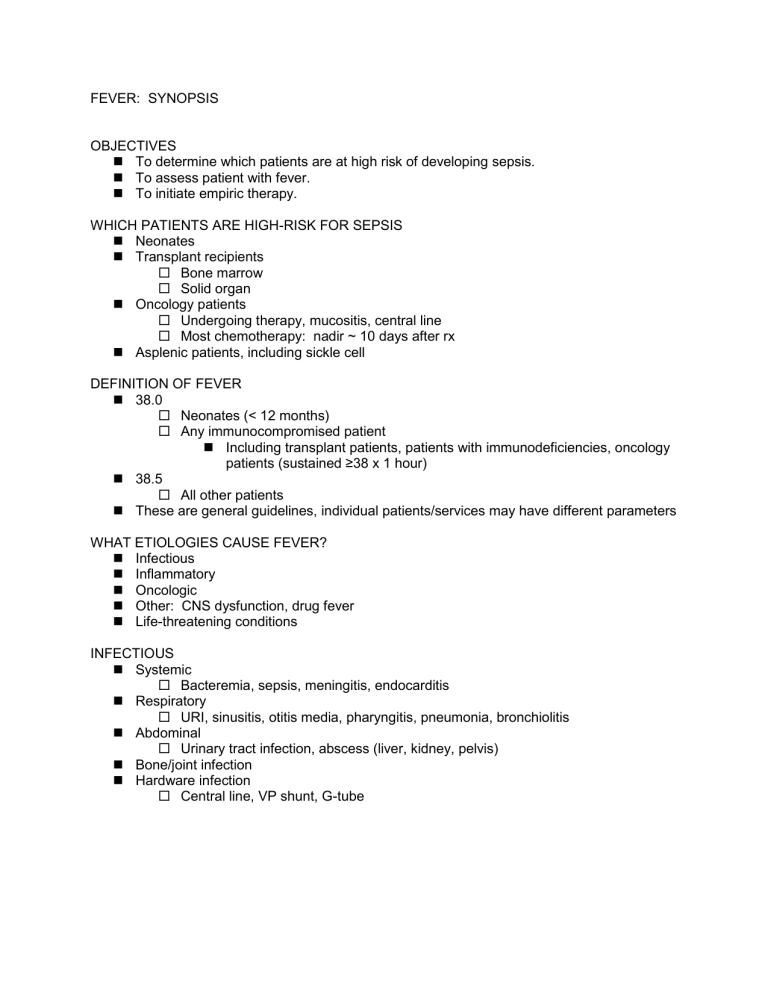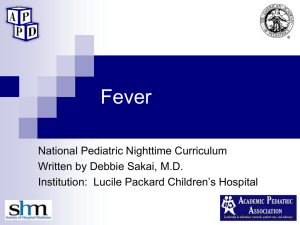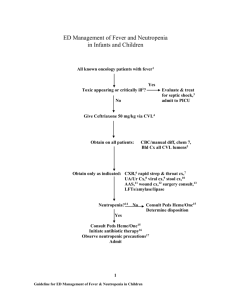FEVER: SYNOPSIS

FEVER: SYNOPSIS
OBJECTIVES
To determine which patients are at high risk of developing sepsis.
To assess patient with fever.
To initiate empiric therapy.
WHICH PATIENTS ARE HIGH-RISK FOR SEPSIS
Neonates
Transplant recipients
Bone marrow
Solid organ
Oncology patients
Undergoing therapy, mucositis, central line
Most chemotherapy: nadir ~ 10 days after rx
Asplenic patients, including sickle cell
DEFINITION OF FEVER
38.0
Neonates (< 12 months)
Any immunocompromised patient
Including transplant patients, patients with immunodeficiencies, oncology patients (sustained ≥38 x 1 hour)
38.5
All other patients
These are general guidelines, individual patients/services may have different parameters
WHAT ETIOLOGIES CAUSE FEVER?
Infectious
Inflammatory
Oncologic
Other: CNS dysfunction, drug fever
Life-threatening conditions
INFECTIOUS
Systemic
Bacteremia, sepsis, meningitis, endocarditis
Respiratory
URI, sinusitis, otitis media, pharyngitis, pneumonia, bronchiolitis
Abdominal
Urinary tract infection, abscess (liver, kidney, pelvis)
Bone/joint infection
Hardware infection
Central line, VP shunt, G-tube
INFLAMMATORY
Kawasaki disease
Juvenile inflammatory arthritis
Lupus
Inflammatory bowel disease
Henoch-Schonlein purpura
ONCOLOGIC
Leukemia
Lymphoma
Neuroblastoma
Sarcoma
OTHERS
CNS dysfunction
Drug fever
LIFE-THREATENING CONDITIONS
Sepsis, febrile neutropenia
Vital sign instability, poor-perfusion, may have altered mental status, disseminated intravascular coagulation
Hemophagocytic lymphohistiocytosis
Splenomegaly, bicytopenia, elevated ferritin, elevated triglycerides, low fibrinogen, hemophagocytosis, low/absent NK cell function, elevated soluble IL2 receptor
Malignant hyperthermia
Following administration of inhaled anesthetics or depolarizing neuromuscular blockers (succinylcholine), at-risk patients include those with myopathy
Muscle rigidity, rhabdomyolysis, acidosis, tachycardia
ASSESSMENT
Vital signs
Repeat physical exam
Overall appearance (sick, toxic)
Central/peripheral lines
Incisions/wounds
VP shunt/tracheostomy/gastrostomy tube
Oral mucosa/perineal area for neutropenic patients
Perfusion
Call for help if concerning vital signs/exam
Fellow or attending
Rapid response team (RRT)/PICU
LABORATORY EVALUATION
What would you do if the patient has hardware (VP shunt, tracheostomy, gastrostomy tube) or central line?
CBC with differential
Blood culture
CSF (tap VP shunt)
What would you do if the patient has a high risk for sepsis?
Immunocompromised
Transplant recipient
Oncology patient
CBC with differential
Blood culture
Urinalysis and urine culture
What would you do for an infant < 2 months of age?
CBC with differential
Blood culture
Catheterized urinalysis and urine culture
Lumbar puncture
Who needs a urinalysis and urine culture?
Circumcised males < 6 months
Uncircumcised males < 1 year
Females < 2 years
Immunocompromised patients
Patients with history of UTI/pyelonephritis
Who needs a lumbar puncture?
Neonates ≤ 2 months
Ill-appearing
Altered mental status
What tests do you send?
Gram stain and culture
Cell count and differential
Protein and glucose
Extra tube for additional studies
Enteroviral PCR, HSV PCR, CA encephalitis project
Consider CRP, ESR
Consider PT/PTT, fibrinogen
Consider chest x-ray
Consider nasopharyngeal DFA
For immunosuppressed patients consider:
Viral PCR studies (ie CMV, EBV, HHV6)
Additional imaging (ie ultrasound, CT scan)
TREATMENT FOR NON-HIGH RISK PATIENTS
May not need empiric antibiotics
Consider the following issues:
Is patient clinically stable?
Are the screening laboratory studies suggestive of infection?
TREATMENT FOR PATIENTS WITH CENTRAL LINES
Ceftriaxone
Vancomycin
TREATMENT FOR NEONATES ≤ 2 MONTHS
If < 28 days old
Ampicillin AND cefotaxime OR
Ampicillin AND gentamicin
Consider acyclovir
If 29-60 days old
Ceftriaxone ± Ampicillin OR Vancomycin
Until CSF results are known (cell count, protein, glucose), initiate therapy with meningitic dosing regimen
TREATMENT FOR FEBRILE NEUTROPENIA
Broad-spectrum antibiotics with Pseudomonas coverage
Ex: use ceftazidime or piperacillin-tazobactam
Consider double coverage for possible resistant Pseudomonas
Ex: add amikacin or tobramycin
Consider gram-positive coverage (central line, skin infections)
Ex: add vancomycin
Consider anaerobic coverage (mucositis, typhlitis)
Ex: use piperacillin-tazobactam or add clindamycin
TAKE-HOME POINTS
Infections are the most common cause of fever in children
During assessment of a child with fever, pay close attention to vital sign changes, overall appearance, and potential sites of infection
Closely monitor for clinical decompensation after antibiotic administration, particularly in patients at high-risk of developing sepsis
REFERENCES
Baraff LJ. Management of fever without source in infants and children. Ann Emerg Med . 2000.
36:602-14.
Meckler G, Lindemulder S. Fever and neutropenia in pediatric patients with cancer. Emerg
Med Clin N Am . 2009. 27:525-44.
Palazzi EL. Approach to the child with fever of unknown origin. UpToDate . 2011
Palazzi DL. Etiologies of fever of unknown origin. UpToDate . 2011.
Tolan R. Fever of unknown origin: A diagnostic approach to this vexing problem. Clin Pediatr .
2010;49:207-13.










